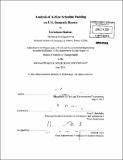| dc.contributor.advisor | Peter P. Belobaba. | en_US |
| dc.contributor.author | Skaltsas, Gerasimos | en_US |
| dc.contributor.other | Massachusetts Institute of Technology. Dept. of Civil and Environmental Engineering. | en_US |
| dc.coverage.spatial | n-us--- | en_US |
| dc.date.accessioned | 2011-11-01T19:55:36Z | |
| dc.date.available | 2011-11-01T19:55:36Z | |
| dc.date.copyright | 2011 | en_US |
| dc.date.issued | 2011 | en_US |
| dc.identifier.uri | http://hdl.handle.net/1721.1/66870 | |
| dc.description | Thesis (S.M. in Transportation)--Massachusetts Institute of Technology, Dept. of Civil and Environmental Engineering, 2011. | en_US |
| dc.description | Cataloged from PDF version of thesis. | en_US |
| dc.description | Includes bibliographical references (p. 125-127). | en_US |
| dc.description.abstract | Every airline passenger faces the risk of arriving late because flight times are subjected to many sources of variability. These can be weather conditions and airspace congestion, imbalances between airport demand and capacity, fleet and crew availability, technical failures and delays in maintenance, and other airline operations such as boarding and fueling. The main objective of this thesis is to explore the most common sources of variability in flight operations and study how U.S. carriers add buffer time (or pad) to scheduled block time to account for them. Using flight data from FAA Aviation System Performance Metrics, we analyze the scheduled and actual flight times on 2359 directional non-stop domestic routes during 2009. The time of each flight is decomposed to delay at gate, taxi-out time, airborne time and taxi-in time. Then, the buffer time of each flight is computed, using as nominal airborne time the lO percentile of the actual airborne time distribution. Our study consists of two parts. First, an aggregate statistical analysis is performed, concentrating on trends and correlations among factors such as buffer, flight time components, route distance, seasonality effects, delays caused by Ground Delay Programs, time of day and day of week, a flight's relative position to other flights operated on the same day by the same aircraft, total number of flights operated by the same aircraft during a day, the role of airport and carriers' network structure. Finally, we perform an econometric analysis through linear regression models to estimate how some of the above factors affect carriers' padding and their on-time performance. The results indicate distance and time of day to be the most important factors that affect schedule padding. While absolute buffer increases with distance, when buffer is measured as a fraction of nominal block time it decreases exponentially. Furthermore, buffer and on-time performance fluctuate strongly over the course of the day, with flights scheduled to arrive during the evening peak having the worst on-time performance, despite the fact that these flights are padded the most. The data reveal that among the studied carriers Southwest pads its schedule more extensively, achieving a very high on-time performance, whereas other low cost carriers pad their flights substantially less, and have a lower on-time performance. Our findings also show that flights destined to the carrier's hub have more buffer than flights destined to spoke airports. Last, competition has a positive effect on schedule buffer and on-time performance. | en_US |
| dc.description.statementofresponsibility | by Gerasimos Skaltsas. | en_US |
| dc.format.extent | 127 p. | en_US |
| dc.language.iso | eng | en_US |
| dc.publisher | Massachusetts Institute of Technology | en_US |
| dc.rights | M.I.T. theses are protected by
copyright. They may be viewed from this source for any purpose, but
reproduction or distribution in any format is prohibited without written
permission. See provided URL for inquiries about permission. | en_US |
| dc.rights.uri | http://dspace.mit.edu/handle/1721.1/7582 | en_US |
| dc.subject | Civil and Environmental Engineering. | en_US |
| dc.title | Analysis of airline schedule padding on U.S. domestic routes | en_US |
| dc.type | Thesis | en_US |
| dc.description.degree | S.M.in Transportation | en_US |
| dc.contributor.department | Massachusetts Institute of Technology. Department of Civil and Environmental Engineering | |
| dc.identifier.oclc | 758169015 | en_US |
